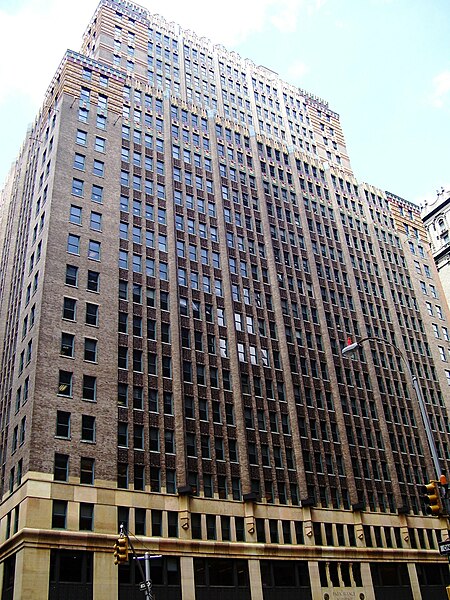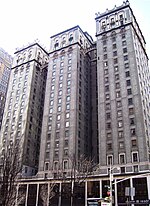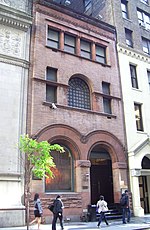2 Park Avenue

2 Park Avenue is a 28-story office building in the Murray Hill neighborhood of Manhattan in New York City. The structure, along the west side of Park Avenue between 32nd and 33rd Streets, was designed by Ely Jacques Kahn and was developed by Abe N. Adelson from 1926 to 1928. The building, known for its facade of brick and colored architectural terracotta, is a New York City designated landmark. The facade of the first three stories is made of stone and largely contains storefronts, except for a central entrance on Park Avenue. The lower section of the building occupies nearly its entire lot, and the building contains setbacks at the 11th, 18th, and 25th stories. The facade contains a polychrome color scheme above the 16th floor, including colored terracotta tiles manufactured by Léon-Victor Solon. The design of the vaulted main lobby dates to the 1970s, when decorations such as a mural by Winold Reiss were added. Office tenants over the years have included the Boy Scouts of America, as well as various textiles, clothing, media, and financial firms. The site had been occupied by the Park Avenue Hotel since the 1870s. Developer Henry Mandel bought the hotel in 1925 in conjunction with a nearby development; he sold the site to Adelson, who erected the building and issued bonds to fund the project. The Continental Bank and Trust Company took over the building in foreclosure in 1935, and real-estate firm Webb and Knapp acquired it in 1953. After several sales in the 1960s, Sheldon Lewis Breitbart bought 2 Park Avenue's leasehold in 1962. Breitbart renovated the lobby after buying the building outright in 1976. Bernard H. Mendik acquired the building in 1986 after several of the building's limited partners accused Breitbart of impropriety. Mendik merged his company in 1997 with Vornado Realty Trust, which sold the building in 2003 to a German firm. Morgan Stanley Real Estate has owned 2 Park Avenue since 2007.
Excerpt from the Wikipedia article 2 Park Avenue (License: CC BY-SA 3.0, Authors, Images).2 Park Avenue
Park Avenue, New York Manhattan
Geographical coordinates (GPS) Address External links Nearby Places Show on map
Geographical coordinates (GPS)
| Latitude | Longitude |
|---|---|
| N 40.746388888889 ° | E -73.9825 ° |
Address
2 Park Avenue
Park Avenue 2
10016 New York, Manhattan
New York, United States
Open on Google Maps






